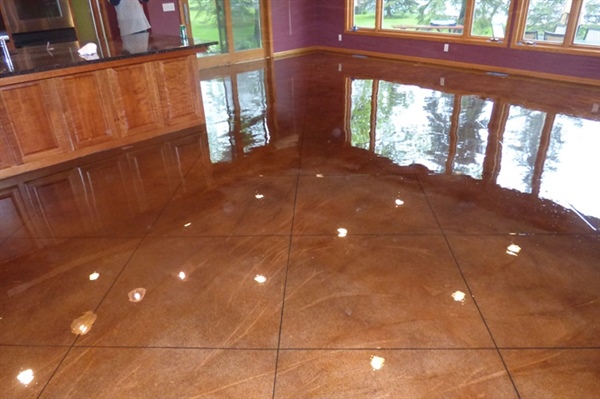Epoxy Flooring vs. Stained Concrete: Which One is Right for You?

Choosing between epoxy flooring and stained concrete can be challenging, especially when considering factors like durability, aesthetics, cost, and maintenance. Both flooring solutions offer unique advantages, making them suitable for different applications.
Whether upgrading a residential space, a commercial facility, or an industrial setting, understanding the key differences between these options will help you make an informed decision.
In this article, we’ll explore essential factors to help you comprehensively understand which flooring solution aligns best with your needs.
How Do Epoxy and Stained Concrete Differ in Durability?
Durability is crucial when selecting a flooring solution, particularly for high-traffic areas or industrial spaces. Epoxy flooring is known for its exceptional strength, forming a thick, protective layer over the concrete substrate. This seamless coating resists impacts, abrasions, and chemical spills, making it ideal for garages, warehouses, and commercial environments.
Additionally, epoxy floors can last 10-20 years with proper care, providing a long-term investment in durability.
On the other hand, stained concrete enhances the existing concrete surface without adding a protective layer. While the staining process penetrates the concrete, it does not offer the same resistance level against physical damage and chemical exposure.
Stained concrete must be sealed regularly to protect against moisture, stains, and wear to improve durability. Though it can last for decades, it may require more frequent maintenance compared to epoxy coatings.
What Are the Aesthetic Differences Between the Two Options?
Epoxy flooring offers a highly customizable look with a variety of colors, finishes, and textures. From solid colors to metallic and flake finishes, epoxy provides a sleek, modern appearance suitable for residential, commercial, and industrial settings. The glossy finish can enhance lighting in a space, adding to its visual appeal.
Additionally, epoxy can mimic materials like granite or quartz, offering a high-end look at a fraction of the cost.
Stained concrete, however, embraces a more natural and organic aesthetic. It enhances the natural variations in concrete, producing a marbled or mottled effect that adds character to floors. Available in both acid-based and water-based stains, stained concrete can achieve earthy tones, rich hues, or even translucent finishes.
This makes it an excellent choice for those seeking a rustic, industrial, or artistic look in residential homes, restaurants, and retail spaces.
Which Flooring Solution is Best for Different Environments?
Choosing the right flooring depends on the environment and its functional needs. Due to its durability, chemical resistance, and seamless surface, epoxy flooring is highly recommended for garages, warehouses, manufacturing plants, and healthcare facilities.
It is also commonly used in commercial kitchens, retail stores, and showrooms, where hygiene and longevity are priorities.
Stained concrete, in contrast, is well-suited for residential interiors, patios, restaurants, and boutique retail spaces. It provides a warm and inviting look while maintaining the structural integrity of the concrete. However, since stained concrete lacks the protective barrier of epoxy, it is not ideal for environments with heavy machinery, chemical exposure, or high moisture levels.
How Do Installation Costs Compare Between Epoxy and Stained Concrete?
Installation costs can vary depending on floor size, condition, and customization. Epoxy flooring typically costs more upfront due to material expenses and labor-intensive application. Prices range from $3 to $12 per square foot, depending on the complexity of the design and the number of coating layers required. Despite the initial investment, epoxy flooring's durability and longevity often make it a cost-effective choice in the long run.
Stained concrete, in contrast, is generally more affordable, with costs ranging from $2 to $8 per square foot. The process involves cleaning, applying the stain, and sealing the surface. While the initial cost may be lower, ongoing maintenance and resealing can add to long-term expenses.
The affordability of stained concrete makes it attractive for homeowners and businesses seeking a decorative yet budget-friendly flooring option.
What Maintenance Requirements Are Unique to Each Flooring Type?
Maintenance plays a key role in extending the lifespan of any flooring solution. Epoxy floors are low maintenance, requiring only regular sweeping and occasional mopping with a mild detergent. Their seamless surface prevents dirt and bacteria buildup, making them an excellent choice for hygienic environments. However, while durable, epoxy can develop surface scratches over time, requiring occasional touch-ups or re-coating.
Stained concrete requires more attention to maintain its appearance and longevity. Sealing is essential to protect the surface from moisture, stains, and wear. Depending on foot traffic and exposure to elements, resealing may be needed every few years.
Additionally, using pH-neutral cleaners is recommended to avoid damaging the stained finish. While routine maintenance is manageable, stained concrete demands more frequent care compared to epoxy flooring.
Get the Ultimate Finish with An Epoxy Floor from Artisan Concrete Pro
Both epoxy and stained concrete offer distinct benefits, making them suitable for different applications. Understanding these factors will help you make the best choice for your flooring needs, whether you prioritize durability, aesthetics, cost-effectiveness, or maintenance ease.
For expert guidance and professional installation, reach out our team at Artisan Concrete Pro or call us today at 612-791-0441 .